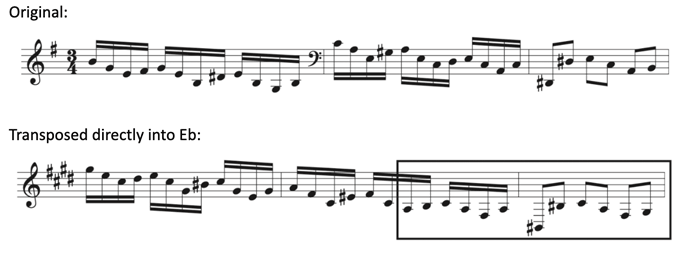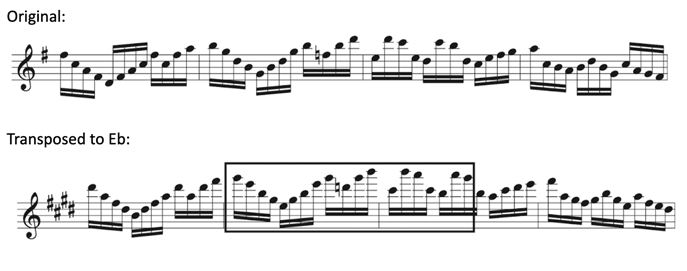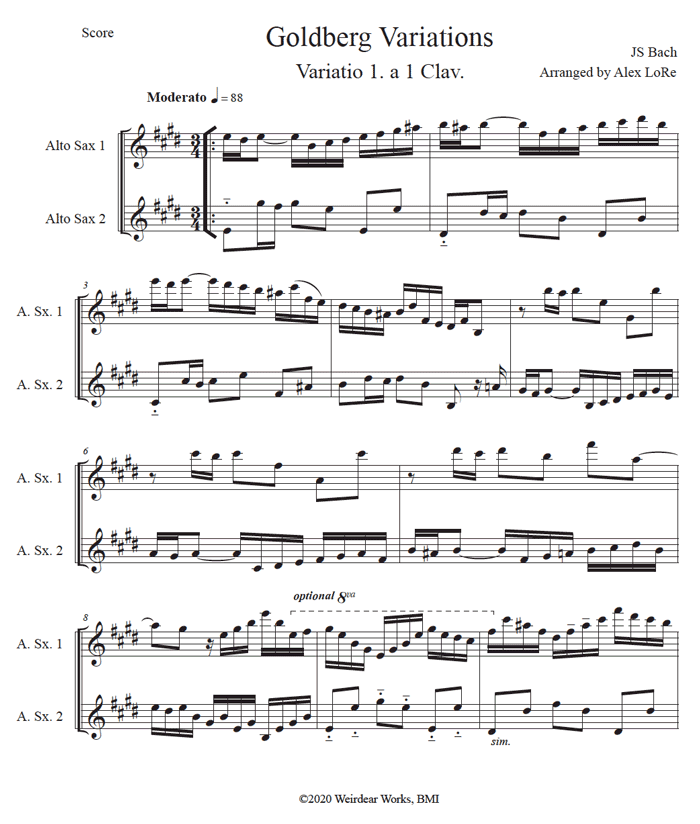Adapting Bach’s Goldberg Variations for Saxophone

Back in March when the COVID-19 quarantine went into effect, it took me a few weeks to gain my bearings. The shock and disbelief of watching all my upcoming tours, performances, and plans get cancelled day after day seemed too surreal to be true. I wasn’t playing my instrument much in those first few weeks. It seemed to take almost all of my energy to process the information about the virus and the immense changes that were taking place around me. With so much uncertainty surrounding the future of performing, I was having a difficult time figuring out what I wanted to practice. When I finally picked my saxophone back up in April, I decided to make a deliberate effort to only play things that would bring me joy.
I was classically trained on the saxophone, so I’ve always enjoyed playing etudes and classical repertoire in general. Practicing etudes by Marcel Mule, Franz Ferling, Eugene Bozza, and other saxophone-focused composers has been a part of my studies since high school. One thing that has always bothered me about the saxophone repertoire, however, is that saxophonists missed out on playing all of the great literature by composers who were writing before the instrument was invented (around the 1840’s). In graduate school I began studying Bach more seriously by reading through the violin Sonatas and Partitas. Though my main goal was to simply become more familiar with Bach’s repertoire, the number of benefits I gained from it was beyond my understanding at the time.
It’s always a great challenge to play music written for other instruments on your specific instrument, because more often than not the material will not fall so easily on your instrument. Want to take it a step further? Read the pieces in concert by transposing on the spot. Take for example, a passage from Bach’s Violin Partita in E major:

Playing this as written seems to pose no real challenge, register wise. However, when transposing into Eb you would read everything up a M6. So, you would end up with something quite different:

All of a sudden you’re thinking in C# major AND have to deal with a bunch of altissimo. And this is just Bach! Apply this to any piece of music from your favorite composer and you’ll never have a boring practice session again. As a sideman with various bandleaders, the ability to read concert charts has proved to be essential. I would estimate that 80% of bandleaders today write charts in concert instead of transposing them into Eb or Bb, so this is a skill that you cannot develop soon enough.
Back to quarantine. Once I made the decision to play music that only brought me joy, I turned again to my familiar book of Bach’s violin partitas. I had also been listening to my favorite recording of Bach’s “Goldberg Variations” by Lars Ulrik Mortensen and thought, “hey, this could be fun to try and play, too.”
I picked up my piano score and began looking at which variation to play first and realized that I would need to solve the problem of playing multiple musical lines at once.
The iOS app, Acapella proved to be a quick remedy, as it allows the user to record multiple videos and splice them together all from the comfort of a smartphone. And thus, with my scores and app in hand, I began my journey into the Goldberg Variations. After inputting the first variation into the app I was hooked and decided it could be a fun challenge to play all of the variations. After I made that commitment and perused through all 31 variations, it occurred to me that this project was going to take some time. But at that point in quarantine, I had nothing but time on my side!
Playing through the variations in concert was pretty straight forward. The alto saxophone proved to be an ideal instrument with which to tackle them, as the range was wide enough to support both the bass clef and the upper treble clef of most of the piano parts. The main issue was when the melodic lines went outside the range of the saxophone. In these instances I had to decide when to bring each line up or down by an octave, and at which point in the line this octave shift made the most sense musically. My main goal was to keep the integrity of the contour of the line and still have it be relatively easy to play.
For example, take these three measures from Variation 8:

We see that the line clearly goes outside of the range of the saxophone. The easy solution is to transpose the line up an octave starting on the A below the staff. This way the shape of the line stays the same without too much tampering.

On the opposite side of the spectrum, some treble clef lines lie primarily in the upper/altissimo register of the alto. Attempting to play those lines was a great technique workout but extremely difficult to consistently play cleanly and in tune. In some cases the soprano saxophone was the horn for the job. For other cases when I wanted to stay on the alto, I would simply transpose the altissimo lines down the octave while keeping the option to play the line as written. Here’s an example from Variation 1:

Here we can see that the melodic line not only hangs out around the altissimo G# – A – B range, but is also skipping back and forth into the upper register pretty quickly. If this were a level in Guitar Hero, it would most certainly be Pro Mode. Here I used my best judgement to switch the line down the octave in order to keep the melodic shape as close to the original as possible, with the option to play it up the octave as well.

Needless to say, I learned a lot by challenging myself to play through all of these amazing pieces. The variations exposed some of my most glaring weaknesses in articulation, intonation, breath support, and fluidity throughout the entire range of the saxophone, but I am grateful for my newfound awareness. Not to mention I now have a huge amount of melodic material to add to my own vocabulary (which is an area that I work on with my private students in order to help them integrate musical ideas from other styles/genres into their own playing).
I am currently working on a transcription book of the Goldberg Variations for saxophone ensemble. The book will range from duos to quartets, and the first edition will be for soprano and alto saxophones, as I played them. Another edition including tenor and baritone saxophones will follow shortly.







September 24, 2020 @ 8:34 am
Very cool. You should check out the arrangement by Yasuaki Shimizu for saxophone quintet (with double bass). It’s on Youtube. http://www.youtube.com/watch?v=kw8i0ct1dTw
The section playing is phenomenal.
September 24, 2020 @ 9:52 am
Thanks Joe! Will check this out for sure.
Adapting Bach’s Goldberg Variations for Saxophone – Saxophonist.org
November 24, 2020 @ 1:29 pm
[…] post Adapting Bach’s Goldberg Variations for Saxophone appeared first on Best. Saxophone. Website. […]